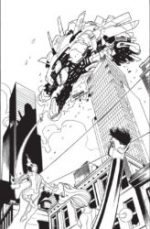I know we’re in limbo with the comics industry right now, but I think this is a good time to look at how we’ve done things. For example, Marvel recently announced that the first issue of X-Men/Fantastic Four would be available in a Director’s Cut format. Should you buy one or pass on it?
WHAT IS A DIRECTOR’S CUT, ANYWAY?
 When a comic sells very well and it’s publisher feels there is enough interest among fans who apparently want to know more about it, they’ll put together what is called a Director’s Cut version. It usually contains behind-the-scenes materials that shows how the book came together.
When a comic sells very well and it’s publisher feels there is enough interest among fans who apparently want to know more about it, they’ll put together what is called a Director’s Cut version. It usually contains behind-the-scenes materials that shows how the book came together.
For example, the aforementioned X-Men/FF #1 Director’s Cut edition will have a draft of the issue’s script, pencil pages, inked pages, color pages, and a variant cover gallery. “Not only will you receive this buzzed-about issue,” said a Marvel news release, “you’ll see the building blocks of its creation.”
Of course, different Director’s Cuts may vary what extra goodies they include, but the idea is to give fans some perspective on how a “director” (or publisher) wanted to put the issue together. The phrase is an allusion to when films add original footage not previously seen to a later release, something the director actually wanted to before it was presented to the public. It’s his or her own “cut,” as it were.
A good example of this is the current movement requesting Zack Snyder’s cut of the Justice League movie. Parts were removed to reduce the run time in theaters that might have better explained some sequences, for instance.
This version of a comic can be particularly useful to those among us who are either considering or actually making their own books to those who simply want to know the process better. Lots of good information to be had there!
Of course, with additional pages comes an increased price tag. Often a $3.99 of $4.99 issue will sell for $7.99 or more in a Director’s Cut. If you have a tight budget, you should seriously weigh the pros and cons of sinking your hard-earned Quatloos into this kind of comic.
COLLECTIBLE?
 Is a Director’s Cut a book you should collect—you know, pick up so it will increase in value over time?
Is a Director’s Cut a book you should collect—you know, pick up so it will increase in value over time?
In a word, no. Honestly, I have never seen a collector or dealer at a con who sold this at a significantly higher price.
Granted, some stores and/or dealers will sell you a copy if they have one in their stock for cover price or a little more, but if you believe you’ll send your kid to college buying these books and selling them later at a huge profit, you’re in for a big disappointment.
WILL A DIRECTOR’S CUT SPOIL YOUR ENJOYMENT OF THE BOOK?
When some people find out how movies or TV shows are filmed, it ruins their ability to just sit back and enjoy the show again. There are fans who simply want to “fall in” to a comic and enjoy the storytelling, so behind-the-scenes information is “TMI” or too much information.
So, if you don’t want the magic of reading a comic ruined for you, you should consider passing on the Director’s Cut. Really.
SO WHY MAKE A DIRECTOR’S CUT?
 It should come as no surprise that one of the big motivations for a publisher to produce a Director’s Cut version of a popular comic is to make money. You know, show BUSINESS and all that.
It should come as no surprise that one of the big motivations for a publisher to produce a Director’s Cut version of a popular comic is to make money. You know, show BUSINESS and all that.
Consider the fact that the publisher likely already has all these materials on hand. Script? Can’t make a comic without it! Penciled pages? Likewise! Same thing for the inks and colors—all these steps in the process should be on hand. Also, while the publisher should have access to these, they may not have to pay much, if anything, for them. (They might give the folks who made the various stages some bonus money, but not a massive amount.) The biggest expense will be the printing! This makes a Director’s Cut a gold mine if you can sell it!
So, if you want more info on the comics production process or just want to see how an issue evolved into what you enjoyed reading and have the money and time, then a Director’s Cut is for you! If not, I’d suggest you invest that money in another comic you might be curious about. Hey, support the industry!
